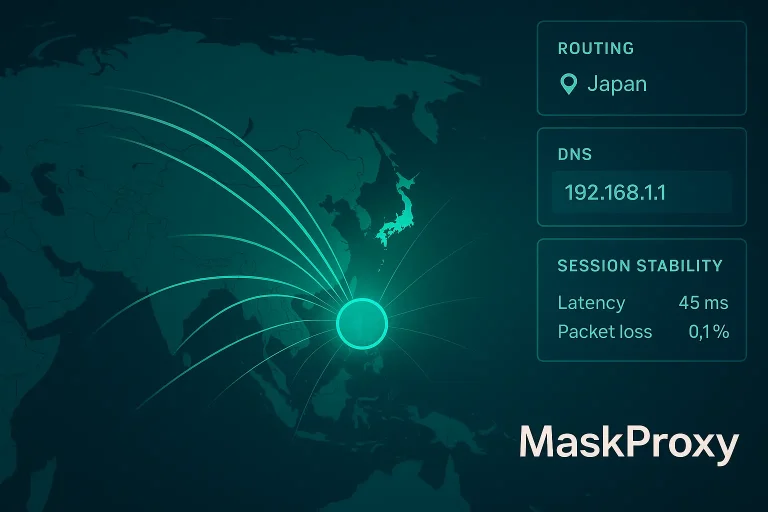Configuring a WireGuard Client on OpenWrt Using luci-proto-wireguard

Teams running distributed marketing, scraping, or QA operations often rely on OpenWrt routers to centralize network control, and many prefer WireGuard for its stability and low overhead. When you configure wireguard client on openwrt using luci-proto-wireguard, you gain a reliable way to route tasks through consistent regional exits—useful when maintaining local identity, reducing detection risk, and improving observability. Some teams even pair this with a stable US proxy endpoint to validate region-locked flows while keeping routing predictable.
Why Operators Use WireGuard on OpenWrt for Multi-Region Workflows
WireGuard provides strong cryptography with extremely low CPU overhead, which helps OpenWrt routers maintain stable throughput during automated tasks. This matters for operations where high-volume traffic or multi-account workloads require consistent performance.
Many MaskProxy users choose OpenWrt because its policy routing tools allow precise steering of app traffic. When combined with WireGuard, this setup reduces unexpected route leakage and ensures outbound identity stays consistent across long sessions.
Business teams also appreciate how WireGuard’s simplicity lowers risk. Fewer moving parts mean fewer failure points during time-sensitive cross-border tasks such as landing-page audits or regional ad checks.
To maintain predictable routing paths, some engineers blend their VPN tunnel with a local regional rotating setup for extra flexibility without losing stability.
Preparing OpenWrt and luci-proto-wireguard for a Reliable Client Setup
Before creating the tunnel, ensure OpenWrt has the required packages: luci-proto-wireguard, wireguard-tools, and kernel modules for your device. This ensures clean integration inside LuCI and avoids mismatched versions that often cause handshake failures.
MaskProxy users running automation frameworks should confirm router time synchronization, since WireGuard depends on accurate clocks. A small offset can break handshakes, leading to inconsistent region presence during platform testing.
It’s also useful to pre-plan the interface name and routing structure. Teams with multi-region workloads often split tasks by interface, making issues easier to detect using OpenWrt’s built-in logs.
Building a Clean Tunnel Interface in LuCI for Consistent Routing
Inside LuCI, creating the WireGuard interface involves entering the server’s public key, endpoint address, and allowed IPs. This step is where many teams implement a variant of their OpenWrt WireGuard client configuration strategy, mapping tasks to specific geographic endpoints for account QA or ad verification.
Operators using MaskProxy often combine the interface with per-host routing rules, ensuring only the right workloads pass through the tunnel. This improves reliability and keeps login behavior consistent across test accounts.
When performing setups similar to configure wireguard client on openwrt using luci-proto-wireguard, engineers frequently define DNS on the interface itself. Regional DNS helps reduce mismatches between IP geolocation and domain resolution.
The interface should remain minimal. Avoid unnecessary peers or overlapping allowed IP ranges, which can confuse OpenWrt’s firewall and cause silent packet drops.
Routing Strategies That Prevent Breakage During Region Switches
Policy-based routing ensures only targeted applications or subnets use the WireGuard tunnel. Teams running geographically diverse tests prefer this method because it avoids disrupting internal traffic.
DNS strategy also matters. Operators maintain local identity by routing DNS through the tunnel, preventing content platforms from detecting mismatched region clues during compliance checks.
Static routes are another important tool. They help maintain consistent egress paths when switching regional tunnels. MaskProxy users running distributed workloads often monitor these routes to avoid flaky path selection.
For tougher identity requirements, some teams test a secondary layer—such as pairing WireGuard with a business-grade rotating proxy pool to detect content variations across markets.
Validating Tunnel Health and Maintaining Observability
After activating the tunnel, inspect the handshake timestamps and data counters. Stable increments indicate a healthy link. MaskProxy’s customers frequently track these metrics to catch packet drops before tasks fail.
Latency monitoring helps you determine if an endpoint is suitable for high-frequency automation. Higher ping may still be acceptable for QA validation but could affect large scraping operations.
It’s also important to test DNS, geolocation, and IP continuity. OpenWrt logs offer enough visibility to identify route leakage or DNS fallback issues. Teams scaling account operations depend on this observability to prevent session flags.
If you integrate a secondary proxy layer, confirm the downstream service matches the tunnel’s expected region. For example, pairing WireGuard with a static residential IP block helps maintain long-lived identity for app testing.
When Proxy Layers Complement WireGuard in Complex Setups
Some operators use WireGuard solely as a secure transport layer, while relying on proxy services to provide fine-grained regional distribution. A strategic combination offers both security and identity consistency. This hybrid design is common for teams conducting multi-region QA or affiliate landing-page checks.
In scenarios requiring rapid rotation, a high-quality rotating proxy workflow allows additional flexibility. Meanwhile, WireGuard ensures transport stability between the router and the chosen endpoint.
For long-duration sessions—especially those tied to app logins or ad accounts—teams frequently use static residential proxies layered beneath WireGuard. This approach provides predictable identity and reduces the risk of session resets.
These combinations help maintain resilience while adhering to platform policies, without engaging in prohibited bypass behaviors.
A well-structured OpenWrt WireGuard client gives growth teams, QA operators, and engineers a stable foundation for controlled regional routing. It reduces session volatility, improves observability, and ensures tasks run predictably across markets. Many professionals extend this setup with a US proxy endpoint or other curated regional paths to refine test coverage. As your workflows scale, review route health, endpoint quality, and integration points to maintain reliability across every region.




